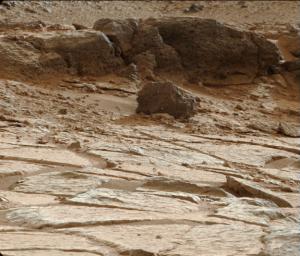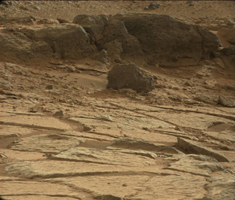
|
‘Point Lake’ Outcrop in Gale Crater
- Click the image above for a larger view
- Full-Res JPEG (1408 x 1200) (340.8 kB)
- Full-Res TIFF (1408 x 1200) (5.1 MB)
Caption:

Figure 1
Click on the image for larger version
One priority target for a closer look by NASA's Mars rover Curiosity before the rover departs the "Glenelg" area east of its landing site is the pitted outcrop called "Point Lake," in the upper half of this image. The outcrop as seen from this angle is about 7 feet (2 meters) wide and 20 inches (50 centimeters) high.
The texture, with its voids or cavities, sets Point Lake apart from other outcrops in the vicinity. A closer inspection may yield information about whether it is a volcanic or sedimentary deposit.
This image was taken by the right (telephoto-lens) camera of the Mast Camera (Mastcam) on the rover during the 193rd Martian day, or sol, of Curiosity's work on Mars (Feb. 20, 2013). It has been white-balanced to show what the rock would look like if it were on Earth. A raw-color version, as recorded by the camera under Martian lighting conditions, is available as Figure 1.
Background Info:
Malin Space Science Systems, San Diego, built and operates Mastcam. NASA's Jet Propulsion Laboratory manages the Mars Science Laboratory mission and the mission's Curiosity rover for NASA's Science Mission Directorate in Washington. The rover was designed, developed and assembled at JPL, a division of the California Institute of Technology in Pasadena.
For more about NASA's Curiosity mission, visit http://www.jpl.nasa.gov/msl , http://www.nasa.gov/mars , and http://marsprogram.jpl.nasa.gov/msl .
Cataloging Keywords:
| Name | Value | Additional Values |
|---|---|---|
| Target | Mars | |
| System | ||
| Target Type | Planet | |
| Mission | Mars Science Laboratory (MSL) | |
| Instrument Host | Curiosity Rover | |
| Host Type | Rover | |
| Instrument | Mast Camera (MastCam) | |
| Detector | ||
| Extra Keywords | Color, Crater, Volcano | |
| Acquisition Date | ||
| Release Date | 2013-06-05 | |
| Date in Caption | 2013-02-20 | |
| Image Credit | NASA/JPL-Caltech/MSSS | |
| Source | photojournal.jpl.nasa.gov/catalog/PIA17071 | |
| Identifier | PIA17071 | |
